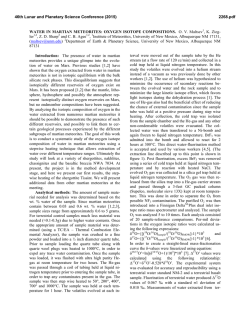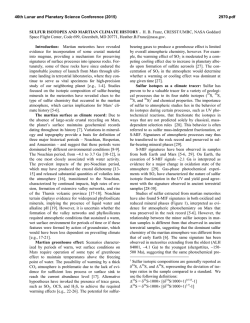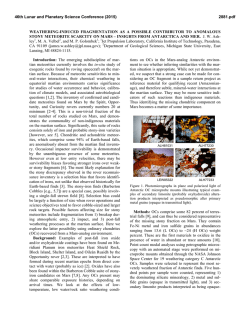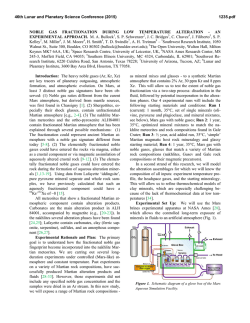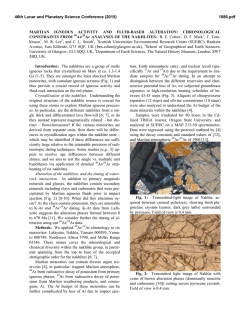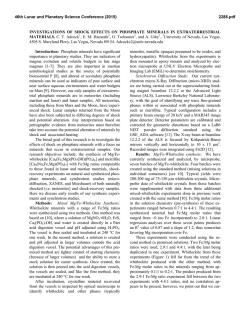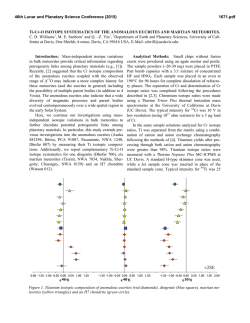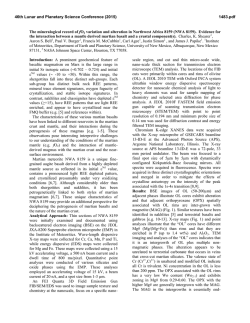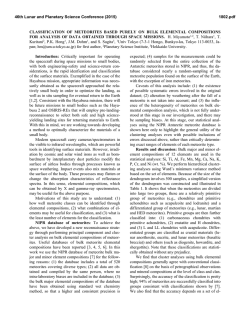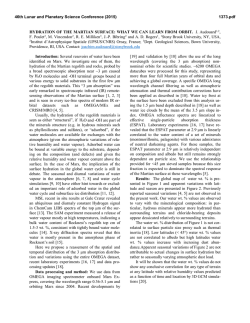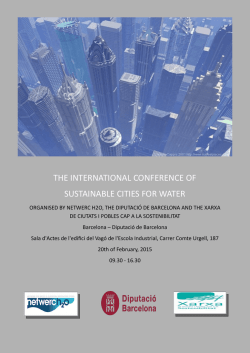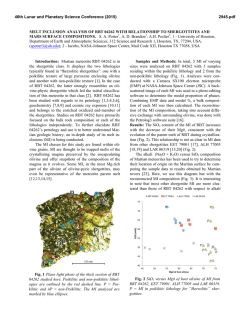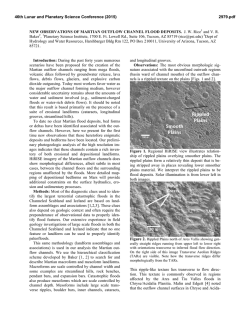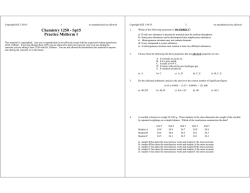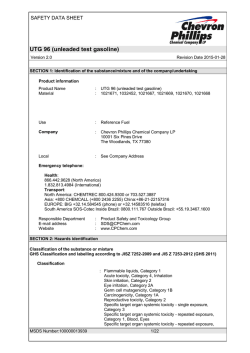
Hydrogen Isotope Systematics of Nominally Anhydrous Phases in
46th Lunar and Planetary Science Conference (2015) 2915.pdf HYDROGEN ISOTOPE SYSTEMATICS OF NOMINALLY ANHYDROUS PHASES IN MARTIAN METEORITES. K. Tucker1, R. Hervig1, M. Wadhwa1, 1School of Earth and Space Exploration, Arizona State University, Tempe, AZ 85287 (E-mail: [email protected]) Introduction: It has long been recognized that the martian atmosphere has a D/H ratio that is ~5-6 times higher than that of terrestrial water reservoirs (e.g., [1]) Analyses by the Sample Analysis at Mars (SAM) instrument suite on the Curiosity Rover have confirmed this and have further shown that surface fines have similarly elevated D/H ratios suggesting that martian surface rocks have exchanged hydrogen with the atmosphere [2,3]. However, the volatile content and hydrogen isotope composition of the martian interior is still not well-constrained. Martian meteorites crystallized from melts derived from the martian mantle, and are currently the only samples of Mars available for analysis in Earth-based laboratories. Hydrogen contents and isotope compositions of relatively earlyformed, nominally anhydrous phases (NAPs) in the martian meteorites can be used to provide constraints on the abundance and source of water in the mantle of Mars (e.g., [1]). In this study we report water contents and hydrogen isotopic compositions of NAPS in eight martian meteorites (both falls and finds) belonging to the shergottite and nakhlite subclasses. These data are used to place upper limits on the water contents of their parent magmas and to understand the processes that may have resulted in variation in the D/H ratios in the phases in these samples. Several previous studies have concluded that relatively high-water contents and terrestrial-like low D/H isotopic ratios in some phases of the martian meteorites are products of terrestrial contamination [1,4,5]. Based on the data reported here, we propose that terrestrial-like hydrogen isotopic compositions observed in some primary igneous phases of the martian meteorites could reflect the actual D/H ratio of the martian mantle. Samples and Analytical Techniques: Polished thin sections of five shergottites (Tissint, SaU 005, QUE 94201, Zagami and Los Angeles) and three nakhlites (Nakhla, Lafayette and Yamato 000593) were studied here. Tissint is a depleted olivine-phyric shergottite that fell in Morocco in 2011 and was recovered soon thereafter [6]. It has a crystallization age of ~575 Ma [7]. SaU 005 (recovered from the Saharan desert and paired with SaU 008) is also a depleted olivinephyric shergottite [8] that has a crystallization age of ~445 Ma [9]. QUE 94201 is a coarse-grained depleted basaltic shergottite that was recovered from Antarctica (terrestrial age of 0.29± 0.05 Ma), and has a crystallization age of ~325 Ma [10-13]. Zagami, which fell in Nigeria in 1962, is a ~180 Ma enriched basaltic shergottite [7,10,11]. The Los Angeles meteorite is also an enriched basaltic shergottite with an age similar to Zagami [11]. Nakhla (observed to fall in 1911), Lafayette (found in 1931) and Yamato 000953 (found in Antarctica) are all clinopyroxenites with crystallization ages close to ~1.3 Ga [14, 15]. In-situ hydrogen isotopic analyses of nominally anhydrous phases in the polished thin sections of each of these eight martian meteorites were performed using a Cameca IMS 6f ion microprobe at Arizona State University. We chose to analyze maskelynites in the shergottites. This is because previous studies have shown this phase to be the least affected by contamination during sample preparation (Mane et al., LPSC abs). We additionally analyzed pyroxenes in the nakhlites since, compared to this mineral in the shergottites, they are typically not as fractured. Each section was gold- or carbon-coated and stored under high vacuum in the ion microprobe sample chamber for at least ~4 hours prior to analysis. A 133 Cs+ primary beam of 8-10 nA was accelerated to 10 keV and rastered over a 40×40 µm2 area. Negative ions were accelerated to 5000 V into the mass spectrometer. For these analyses, we detected ions restricted to only a circular area ~17-20 µm in diameter. A 40 eV energy window was used, and the mass spectrometer was operated at a mass resolving power of ~400 (wide open). 1 H and 2D were detected on an electron multiplier, and 16 O on a faraday cup. The area of interest was presputtered for 2-4 minutes to remove surface contamination. Each analysis cycle consisted of measuring H (1 sec) and D (10 sec) in peak switching mode, with each measurement run consisting of 60-200 cycles; 16 O was measured at the end of each run. Water content was determined using the measured H-/O- ratio which was calibrated to determine H2O concentrations using hydrous rhyolites as standards. Natural obsidian (δD = -150 ‰ [16]) was used as the standard for the determination of the hydrogen isotope compositions. Results and Discussion: This study presents 86 individual analyses of water contents and hydrogen isotope compositions on NAPs in the 8 martian meteorites discussed earlier: 12 on Tissint maskelynites, 5 on SAU 005 maskelynites, 14 on QUE 94201 maskelynites, 9 on Zagami maskelynites, 10 on Los Angeles maskelynites, 11 on Nakhla pyroxenes, 13 on Lafayette pyroxenes, and 12 on Yamato 000593. The following are the ranges of water contents and δD values (i.e., D/H ratio relative to the terrestrial standard in parts per 1000) for the phases analyzed in each meteorite: 310−1407 ppm H2O and -115−+722‰ δD in 46th Lunar and Planetary Science Conference (2015) Tissint; 1402-3262 ppm H2O and -205−-17‰ δD in SaU 005; 171−396 ppm H2O and -36−+390‰ δD in QUE 94201; 100−166 ppm H2O and -91−+849‰ δD in Zagami; 138-275 ppm H2O and +104−+402‰ δD in Los Angeles; 69−1332 ppm H2O and -95−+349‰ δD in Nakhla; 154−1825 ppm H2O and -174−-142‰ δD in Lafayette; and 456-1602 ppm H2O and -317−-178‰ δD in Yamato 000593. The results presented here show that there is extensive variation in the water contents and hydrogen isotope compositions of NAPs in the shergottites and nakhlites. As can be seen in Fig. 1, our data fall within the range of compositions reported previously for NAPs in shergottites, Chassigny and ALH84001, although the variation in the previously reported data is significantly larger (possibly a sampling issue). As mentioned earlier, the variation in water contents and δD could be due to magmatic evolution (for example, by processes such as dehydrogenation or dehydration) during crystallization, near-surface interaction with martian crustal fluids, shock during (resulting in either atmospheric implantation or isotopic fractionation) and terrestrial contamination. As we have suggested previously [17,18], the spread in the data shown in Fig. 1 could represent mixing between three distinct reservoirs: A martian atmosphere-like high δD and high H2O reservoir (upper left of Fig. 1a); a terrestrial-like low δD and low H2O reservoir (lower right of Fig. 1a) that likely represents the martian mantle; a terrestriallike low δD and high H2O reservoir (lower left of Fig. 1a) that may represent terrestrial contamination, but may also represent a martian reservoir (for example, late-stage magmatic volatile-rich fluids). Many of the shergottite maskelynites have relatively low water contents similar to those in terrestrial volcanic plagioclase, but a significant fraction have >200 ppm H2O. If terrestrial contamination can be ruled out, and if the measured water content in these maskelynites is assumed to be magmatic in origin, the estimated H2O abundance in coexisting melt (using a plagioclase-melt partition coefficient of ~0.05 [19]) ranges from as low as ~0.2 wt.% to well over 10 wt.%. The latter value is too high compared to recent estimates of the water contents of shergottite parent magmas (e.g., [20]), and may indicate that the high water contents in some of the maskelynites do not reflect magmatic compositions but rather may be the result of post-magmatic processes (on Mars or Earth). Conservatively, we estimate that the lowest estimate of ~0.2 wt.% water may represent an upperlimit on the water content of shergottite magmas. This value is consistent with estimates of the pre-degassing water contents of ~0.1-0.3 wt.% for shergottite magmas based on apatite 2915.pdf compositions [20]. Similarly, using a pyroxene-melt partition coefficient of ~0.02 [21] we have estimated that nakhlite parent magmas contained no more than ~0.3 wt.% water. Figure 1: δD vs. 1/H2O (ppm) in nominally anhydrous phases in the martian meteorites. a) Previously published data for maskelynites, pyroxenes and/or olivines in the depleted shergottites Tissint [4] and SaU 005 [5]; intermediate shergottite EETA 79001 [5]; enriched shergottites Zagami and Shergotty [5]; as well as Chassigny and ALH 84001 [5]. Apices of the gray shaded triangle likely represent martian or terrestrial endmember compositions (see text for details). The outlined box is the compositional range of data reported here (shown in 1b). b) Data presented in this study for maskelynites and pyroxenes in martian meteorites (see text for details). References: [1] Leshin, L.A. (2000). GRL 27. 2017-2020. [2] Webster et al. (2013) Science 341. 260-263. [3] Leshin et al. (2013) Science 341. 1-9. [4] Mane, P. et al. (2013) LPSC XLIV Abstract #2220. [5] Boctor, N.Z. et al. (2003) GCA 67, 3971-3989. [6] Aoudjehane, C. et al. (2012) Science 31, 785788. [7] Brennecka, G.A. et al. (2014) MAPS 49, 412-418. [8] Goodrich, C.A. (2003) GCA 67, 3735-3772. [9] Shih et al. (2007) LPSC LXIV Abstract #1745. [10] Shih C.Y. et al. (1982) GCA 46, 2323-2344. [11] Nyquist, L.E. et al. (2001) Space Sci. Rev. 96. [12] McCoy, T. et al. (2011) PNAS 108, 19159-19164. [13] Nishiizumi, K. & Caffee, M.W. (1996) LPSC XXVII 961-962. [14] Shih et al. (1998) LPSC XXIX Abstract #1145. [15] Nakamura et al. (2002) NIPR Symp. Antarctic Meteorites 27, 112-114 (abstract). [16] Ihinger, P.D. et al. (1994) Rev. in Min & Geochem. 30, 67-121. [17] Tucker et al. (2014) LPSC XLV Abstract #2190. [18] Tucker et al. (2014) 77th Met. Soc. Meeting Abstract #5399. [19] Hamada et al. (2013) EPSL 365, 253-262. [20] McCubbin, F. et al (2012) Geology 40, 683-686. [21] Tenner et al. (2011) Contr. to Min. & Pet. 163, 297-316.
© Copyright 2025
